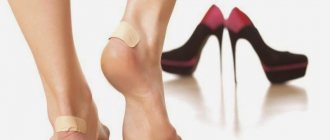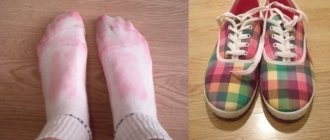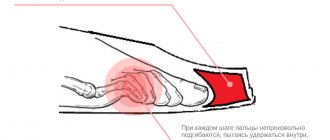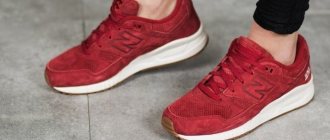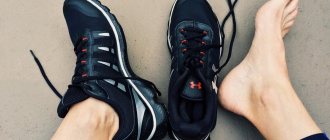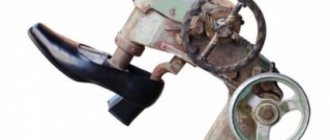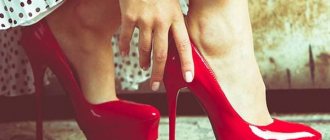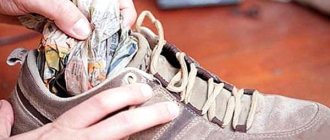New shoes or sandals look so great on your feet and attract the admiring glances of others to you, and at the same time you are experiencing inhuman torment from the fact that your feet have rubbed into blood? Sound familiar?
Probably every woman at least once in her life has encountered chafing and soft calluses in the area of her feet, which cause discomfort and completely deprive her of the joy of a desired purchase. Moreover, a huge misconception is the opinion that only hard model boats and other similar items can rub. You can rub your skin into blood with sneakers, soft weightless ballet shoes, and even beach flip-flops.
How to avoid becoming another victim of “bloody terror” from summer shoes? What to do if a new couple rubs? What should those who constantly experience such an undesirable phenomenon do? We answer these and other questions in detail, and also offer effective ways to solve the current problem.
Beauty requires sacrifice?
Which shoes should you choose – comfortable or beautiful? High-heeled shoes or sandals will certainly add a sexy touch to your look, but the comfort of such a pair is out of the question. Therefore, if you have to be on your feet all day, rushing around the city on public transport, it is much more practical to wear ballet flats or moccasins. In worn-in, low-speed shoes, you will feel more confident when catching up with a bus or trying to squeeze into a crowded subway car.
It's another matter if elegant shoes are a mandatory element of the office dress code. Before you take your new pair out to work, you should walk around in them at home, but don’t try to act like a “model walk.” If you feel discomfort in the heel or toe area, then before going out, you should adapt the pair as much as possible, otherwise, you risk developing calluses even in that short period of time while you flaunt your new look from the door of your own apartment to a car parked in the yard .
Blisters, calluses, chafing are seasonal problems for women’s feet.
Why do chafing and blisters on the back of the heels and in the toes appear more often in the warm season? Firstly, in the summer the likelihood of swelling increases, which is why at the end of the day it can be difficult to take off shoes that were just in time. The material of the shoes rubs against the already swollen skin, which leads to the formation of so-called “dropsy”.
Secondly, in the hot season we sweat intensely. Sweat mixes with particles of dust, sand and other similar delights and becomes a kind of abrasive, “sealed” between the inner surface of the shoe and the skin. Naturally, the lucky ones manage to get by without calluses in such a situation.
Thirdly, the size and fullness of the new shoes are chosen incorrectly, and the shoes either squeeze the foot like a vice, or, on the contrary, mercilessly fidget and rub the delicate skin of the feet. In this case, you can try to wear your shoes in or insert special insoles to prevent the foot from “lobbing” or excessive sliding.
Cold
To implement this method, you will need to fill a plastic bag with cold water. It is placed inside the shoes that need to be stretched and the shoes are placed in the freezer.
When water turns into ice, it increases in volume, which is what causes stretching.
Just make sure the bag has no holes and is tied well.
How to remove an ice pack? You can't pull by force. Remove the boots from the freezer and place them in a warm place. When the ice melts a little, you can easily take out the bag and try on the shoes already stretched.
Elimination of swelling as a prevention of chafing of the feet
Each person's body reacts differently to heat and physical activity. And increased swelling of the legs does not always indicate serious illness. But it can easily become the cause of blisters and chafing!
If you have a tendency to edema, try to avoid high-heeled shoes, tight, not yet properly worn-in sneakers, and sandals on particularly hot days. Uncomfortable shoes will only aggravate the swelling, and will most likely irritate the skin into watery calluses.
At work, you should always have shoes with low heels or wedges, with uppers made of natural materials. They will be a real salvation for your feet after elegant stiletto heels or sandals with hard buckles. Daily massage of the feet and legs using special gels will make blood vessels and capillaries work more actively, reducing swelling and, accordingly, the risk of chafing.
Castor oil
Castor oil has a good effect on the material. New shoes should be immediately treated with this oil and walked around a little.
Castor oil can soften the butt well, and sometimes works better than other home remedies.
For an even better effect, mix castor oil, melted beeswax and turpentine. All components are taken in equal quantities.
This composition is rubbed inside and out. Thanks to these products, the shoes are well saturated with oils, the leather becomes softer and more elastic.
In addition, this mixture protects against the negative effects of moisture. During rain, droplets of water will not be absorbed into the material; they will remain on the fabric in the form of droplets and then flow down onto the asphalt.
Silicone insoles and liners
Silicone insoles with a cooling effect are an effective solution for preventing calluses and corns. Such “gadgets” will protect your skin from excessive friction on the inner surface of your shoes and help maintain the beauty and health of your feet, even if you decide to have a summer romance with spectacular stiletto sandals.
You can find a variety of silicone products on sale:
- Inserts under the toes, under the heel;
- Full insoles;
- Soft self-adhesive strips;
- Heels and short socks.
For example, if the main problem area of the shoes is the hard edge, which literally cuts into the skin and injures it, then it is enough to glue strips of silicone around the perimeter of the cutout, and this will protect your feet from chafing. If you have previously developed soft calluses on the soles, then you should think about purchasing special inserts that completely or partially cover the original insole.
What to do with calluses
A callus is formed from excessive rubbing of the skin and is a bubble filled with liquid, which then bursts. An infection can easily penetrate an open wound, which can lead to suppuration and is very dangerous to health, so you should not take calluses lightly.
If the bubble in front of your toes or on the heel has burst, treat the area with peroxide, and then apply brilliant green around the wound. You can also use alcohol. There is no need to pour it onto the damaged area; do it with a cotton pad or ear swab. If the bubble is still full, press it with a clean bandage, and then carry out the disinfection procedure. An open wound can be sealed with a bactericidal adhesive plaster.
Sprays for stretching shoes
Just a couple of hours ago in a shoe store you admired the beauty of the brand new shoes you just purchased, but now you realize that they are a little small for you? If you really like the chosen pair, you can try to solve the problem with the help of a special foam, a spray for stretching shoes.
The purchase of such a product becomes especially relevant if you need to break in expensive shoes, and you are afraid of hopelessly ruining a pair by applying one of the many tips from the people. Special cosmetics for shoe care can soften and stretch natural leather to a certain extent without damaging the appearance of the product.
Rubs the edge of the shoes
If the edge of your shoes rubs
Sometimes it happens that everything is fine in the shoes, but one edge of it literally digs into the skin.
This usually happens at the junction of two or more parts. If you don't know what to do with such a pair, try purchasing the same silicone self-adhesive pads as special tapes for sandals. They have the shape of a small circle or oval and are attached from the inside to the place where there is a defect. Usually this is enough to make wearing shoes easier and more comfortable. To the list of news
Popular ways to break in new shoes
On the Internet you can find a huge number of ways to wear shoes using improvised means, the laws of physics and even atmospheric phenomena. To avoid rubbing your feet into blisters and wounds, you can do the following in advance:
- Rub the inside of the hard heel of your shoes with soap or a candle and walk around in your shoes a little. Repeat several times during the day;
- Put the shoes on a wet sock and walk around in them until they dry completely. In most cases, the effect of using this method is positive;
- To soften the hard back of boots or ankle boots, you can tap it with a hammer, after covering it with a clean soft cloth;
- At night, wrap the box with a new pair in a large damp towel; by morning the shoes will become more pliable;
- Fill plastic bags with water, put them in shoes and put the pair in the freezer overnight;
- Walk in new shoes in the rain. When the shoes dry, they will fit perfectly on your feet.
Shoemaker tips
To wear shoes without damaging the product, you need to follow the recommendations of professionals:
. To do this, a small amount of the substance is applied to an inconspicuous area of the product. The procedure is allowed only if there are no negative changes.
Regardless of which product you choose, you should make sure it is safe- It is permissible to use special products only when stretching natural leather. The artificial material will deteriorate under their influence.
- Patent leather shoes should not be doused with boiling water or placed in the freezer.
- When using a hair dryer, it is recommended to cover the material with a damp cloth. Due to this, it is possible to prevent the material from drying out.
- When using a hammer to soften it, it is important not to overdo it. Rigidity must be maintained, otherwise the shoes will become shapeless and even more uncomfortable.
The best and safest way to solve the problem is to seek help from professionals. An experienced shoemaker will be able to do the job efficiently without harming the material. It has all the necessary accessories to soften the backdrop.
If your shoes are rubbing, and there are a couple of hours left before leaving?
Do you have very little time left to adapt your shoes to painless and safe walks? You can use the same method with wet socks, but use alcohol instead of water, which dries much faster and further softens the natural material. But use alcohol to stretch shoes with caution, as it can change the color of the pair.
If your shoes are not too tight, a few hours before going out, you can lubricate your feet with rich baby cream, and try to ensure that it is absorbed into the skin as much as possible. This preventive measure will help prevent chafing.
Only an hour before going out, and you have absolutely nothing to wear for an important date? It's time to take emergency measures. You need to put on your shoes with the warmest socks, turn on the hairdryer and gradually blow hot air onto problem areas (heel, toe). At the same time, you should try to move your leg to speed up the stretching process.
If the boots are pressing
Not all methods are suitable for stretching boots. It is much more difficult to soften such shoes, so special products are used.
Pencil
The product helps soften backdrops. With its help, it is possible to protect the heel from further rubbing.
After treatment with a pencil, shoes on the inside become smooth and do not have a negative effect on the skin. There are no marks left on tights or socks, as well as on the shoes themselves.
Band-Aid
It is glued not only to the heel, but also to the heel. But when walking, sometimes the patch often comes off and becomes crumpled. Because of this, the legs suffer more. Therefore, this method should be used in exceptional cases.
Silicone pads
Silicone shoe inserts help avoid chafing. They are fixed in places of high pressure. Additionally, an adhesive plaster is used.
Patches and gaskets
If the cause of chafing is a hard seam, this method will help eliminate the problem. The seam should be covered with a soft cloth.
The patch should be sewn to the backdrop or glued. However, this option is not suitable if the shoes are very tight.
New shoes rubbed my feet: first aid!
So, the worst has already happened, your feet are bleeding, and in the middle of the working day you can barely drag your feet, while trying to maintain a firm gait and a sweet expression on your face. The worst thing when a dropsy breaks through is that particles of dust and other contaminants get into the wound. If you have the opportunity to take a short break or simply no longer have the strength to go and endure how the hard back continues to wear your skin down to the bone, then:
- Sit down and carefully remove your shoes (it is also advisable to remove socks and tights);
- Let your feet breathe a little while you assess the scale of the tragedy, inspect your purse for wet wipes, bandages, adhesive plaster, hand sanitizer;
- If possible, the wound should be washed with at least tap water and treated with any alcohol-containing product or antiseptic. It will hurt, but you will have to be patient. The main thing is not to try to tear off the skin that has come off in places where the dropsy breaks out;
- Apply the patch and sit for at least another 10-15 minutes. If you don’t have a patch in your purse, you can put a kind of barrier of wet wipes between the inner surface of the shoe and the skin, this will allow you to somehow get to the nearest pharmacy.
Treating chafing and calluses is a rather lengthy and painful process. Therefore, it is worth at least trying to prevent their occurrence. Do you think that wearing the same comfortable pair all the time is boring? Then we recommend that before going out for the first time in new shoes or sandals, you give them a “test by combat” (walking, jumping, steps) at home, and if you are not satisfied with the result, you need to break the pair in at home in advance. Moreover, now you know more than one way to do this.
How to treat a sore area using traditional methods?
Folk remedies in combination with conservative therapy work well against all types of calluses:
- Lemon juice. Lemon juice works well for dry calluses. Apply a slice of fresh lemon to the keratinized skin of the growth, secure with a band-aid, and the next morning remove and remove the defect.
- Oat straw. Prepare a decoction of oat straw in proportions of 1:10. Take hot baths with this decoction every day (15 minutes each). Immediately after such procedures, remove rough calluses.
- Dandelion juice. Every day you need to lubricate the damage with dandelion juice, which can be squeezed from the flowers or stems. You need to repeat the procedure until the calluses completely disappear.
- Meadow geranium. Meadow geranium poultices work well against minor defects. Daily procedures will help you forget about calluses in just a couple of weeks.
- Vinegar and chicken egg. Pour 80% vinegar into a glass and place a fresh chicken egg in it. After 7–8 days it should completely dissolve in this solution. Apply the resulting mixture to the sore spot and bandage it. If you feel pain, you should immediately remove the bandage and rinse off any remaining product under running water.
